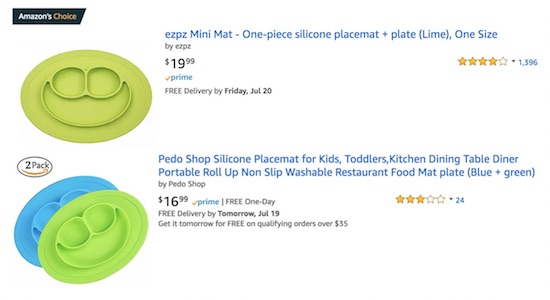
Screen shot taken from Amazon.com on July 18, 2018 to substantiate the statements made in the article.
Parents have plenty to be worried about – rising tuition costs, ever-present social media, and the general dread that some harm may befall their child. But how many parents are unaware of the potential danger lurking in their child’s formula, toys, strollers, and accessories? Counterfeit versions of popular children’s products have introduced a new, often indistinguishable risk that parents unknowingly welcome into the nursery.
Online retailers – Amazon, in particular – are often new parents’ lifeline to the world of swaddles, pacifiers, diapers, and everything in between. Amazon specifically targets new parents and their near endless needs for participation in its Prime program, offering that Amazon “can manage almost all your baby’s needs from literally one place.” New parents are big business for both online and brick-and-mortar retailers. According to a report from Hyve, new parents spend approximately $6,200 on baby-related goods and services during the child’s first year of life. Industry analysts project the global baby products market to reach $121 billion by 2025.
Last month, pNeo, the producer of the popular BabyShusher device, made the public aware of counterfeit versions of its white noise machines. According to pNeo, test buys from Amazon returned counterfeit BabyShushers with corroded batteries and protruding wires. BabyShushers are intended to be used in close proximity to sleeping infants. BabyShusher has publicly complained about Amazon’s lackadaisical response to its business and welfare concerns.
Amazon certainly isn’t the only marketplace where new parents can be duped into courting danger. The Baby Carrier Industry Alliance published a guide on identifying counterfeit baby carriers offered on DHgate and eBay. The sites offered counterfeit versions of well-known and trusted brands, such as Ergo at significant discounts.
Little ones are potentially at risk from a range of counterfeit products, including products that interact with children in the most intimate of ways. For example, Ezpz’s popular Happy Mat, a silicone feeding mat, suffered from counterfeit versions flooding the market in Toronto. Genuine Happy Mats are produced from 100% food-grade silicone that has been rigorously tested, approved by the FDA, and certified by the U.S. Consumer Products Safety Commission. The composition of the counterfeit Happy Mats almost certainly does not meet the same stringent requirements. Counterfeiters are able to offer products at much lower prices than the genuine goods because they use cheaper materials, do not invest in expensive quality assurance programs, or comply with government safety guidelines. For example, chemical analyses of counterfeit children’s toys in Europe found phalate levels exceeding eighteen times the legal limit. Phalates have been linked to increased risk of cancer, asthma, and fertility problems later in life if ingested. These cheaper, counterfeit products offer short term benefits on price at the cost of increased long-term health risks.
How should new parents avoid putting their young children in unnecessary harm?
First, caregivers should be vigilant in purchasing directly from the brand, either through its website or through its authorized retailers. Most brands – including UPPABaby and ErgoBaby – provide prospective customers with online tools to identify an authorized retailer. Sourcing through the approved channels allows parents to be confident in the provenance of their purchases.
Second, if shopping on an online marketplace, pay close attention to the listed price. It’s tempting to seek out a bargain while faced with the mountain of costs associated with parenthood, but prices that are significantly outside of the manufacturer’s suggested retail price should be viewed with suspicion. Furthermore, when products from U.S. brands are offered below the manufacturer’s suggested retail price, and are located in foreign countries, exercise caution. For example, at the time of publication, a leading U.S.-based swaddle blanket manufacturer’s products were offered on Alibaba for $.88 per blanket, a 95% discount from the manufacturer’s suggested retail price.
Finally, note negative comments and feedback. Nearly all online marketplaces allow users to view the feedback accrued by sellers. This can be difficult to sift through, but the extra legwork outweighs the potential risk. On Amazon, shoppers should note that feedback is tied to the listing rather than the individual seller. It can be an exercise in futility to determine the source of a comment regarding counterfeit products, but the presence of counterfeit products on the ASIN should give parents immediate pause.
The burden, however, is not just on the consumer. Brands should be pro-active in the defense of their intellectual property. Spending precious budget dollars on preventative measures is often a difficult sell, but the return on investment can be dramatic when a brand considers the economic and reputational harm from an insidious counterfeit problem.
All brands should engage in some form of online monitoring to gain insight into its activity in e-commerce, particularly suspicious listings of its products. As pressure mounts on online marketplaces to act on this issue, sites such as Alibaba and DHgate have offered brands online platforms to report infringing listings. U.S.-based sites such as Amazon and eBay developed brand-focused tools to cut through the bureaucracy of reporting infringement. Amazon’s Brand Registry and eBay’s VeRO program are good first steps for brands to efficiently enforce their rights on two of America’s most popular marketplaces.
Brands should also leverage the resources of the U.S. Government to block products from entering the U.S. stream of commerce. U.S. Customs and Border Protection allows brands to record their trademarks in its Intellectual Property Rights system as a means of increasing the rate of seizing counterfeit products at the ports. With modest investments in training and intelligence sharing, brands can partner with Customs to stop counterfeit products from ever reaching their destinations.
Finally, brands should turn the intelligence gathered from online monitoring, test buys, engagement with marketplaces, and Customs seizures into actionable data. Aggressively targeting resellers reduces the rate of recidivism, can result in the disgorgement of profits and the forfeiture of remaining counterfeit inventory, and can provide brands with intelligence that allows them to move up the chain to engage distributors and manufacturers. Even if brands are hesitant to spend on investigating manufacturers – especially abroad – diligent enforcement can send a message to the marketplace that carrying counterfeit versions of your brand’s products just isn’t worth it.
Protecting children from the very real harm from counterfeit baby products is a common goal for both parents and brands. Although no parent will ever achieve the ultimate dream of protecting their child from harm out in the world, some diligence and active participation by baby product manufacturers can make the home an even safer place.

![[IPWatchdog Logo]](https://ipwatchdog.com/wp-content/themes/IPWatchdog%20-%202023/assets/images/temp/logo-small@2x.png)

![[Advertisement]](https://ipwatchdog.com/wp-content/uploads/2024/05/Quartz-IP-May-9-2024-sidebar-700x500-1.jpg)
![[Advertisement]](https://ipwatchdog.com/wp-content/uploads/2024/04/Patent-Litigation-Masters-2024-sidebar-last-chance-700x500-1.jpg)

![[Advertisement]](https://ipwatchdog.com/wp-content/uploads/2021/12/WEBINAR-336-x-280-px.png)
![[Advertisement]](https://ipwatchdog.com/wp-content/uploads/2021/12/2021-Patent-Practice-on-Demand-recorded-Feb-2021-336-x-280.jpg)
![[Advertisement]](https://ipwatchdog.com/wp-content/uploads/2021/12/Ad-4-The-Invent-Patent-System™.png)






Join the Discussion
One comment so far.
mike
July 25, 2018 09:52 amJust a little quibble from a chemist – “phthalate”, not “phalate”